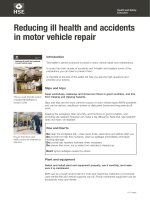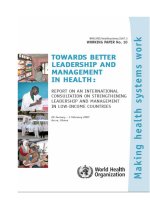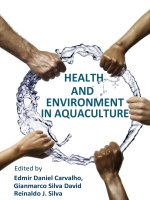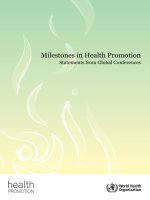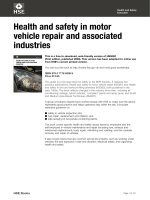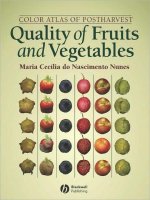Vegetables, fruits and herbs in health promotion
Bạn đang xem bản rút gọn của tài liệu. Xem và tải ngay bản đầy đủ của tài liệu tại đây (5.03 MB, 343 trang )
Health Promotion
Boca Raton London New York Washington, D.C.
CRC Press
Edited by
Ronald R. Watson, Ph.D.
Vegetables,
Fruits,
and Herbs in
© 2001 by CRC Press LLC
CRC SERIES IN
MODERN NUTRITION
Edited by Ira Wolinsky and James F. Hickson, Jr.
Published Titles
Manganese in Health and Disease, Dorothy J. Klimis-Tavantzis
Nutrition and AIDS: Effects and Treatments, Ronald R. Watson
Nutrition Care for HIV-Positive Persons: A Manual for Individuals and Their Caregivers,
Saroj M. Bahl and James F. Hickson, Jr.
Calcium and Phosphorus in Health and Disease, John J.B. Anderson and
Sanford C. Garner
Edited by Ira Wolinsky
Published Titles
Handbook of Nutrition in the Aged, Ronald R. Watson
Practical Handbook of Nutrition in Clinical Practice, Donald F. Kirby
and Stanley J. Dudrick
Handbook of Dairy Foods and Nutrition, Gregory D. Miller, Judith K. Jarvis,
and Lois D. McBean
Advanced Nutrition: Macronutrients, Carolyn D. Berdanier
Childhood Nutrition, Fima Lifschitz
Nutrition and Health: Topics and Controversies, Felix Bronner
Nutrition and Cancer Prevention, Ronald R. Watson and Siraj I. Mufti
Nutritional Concerns of Women, Ira Wolinsky and Dorothy J. Klimis-Tavantzis
Nutrients and Gene Expression: Clinical Aspects, Carolyn D. Berdanier
Antioxidants and Disease Prevention, Harinda S. Garewal
Advanced Nutrition: Micronutrients, Carolyn D. Berdanier
Nutrition and Women’s Cancers, Barbara Pence and Dale M. Dunn
Nutrients and Foods in AIDS, Ronald R. Watson
Nutrition: Chemistry and Biology, Second Edition, Julian E. Spallholz,
L. Mallory Boylan, and Judy A. Driskell
Melatonin in the Promotion of Health, Ronald R. Watson
Nutritional and Environmental Influences on the Eye, Allen Taylor
Laboratory Tests for the Assessment of Nutritional Status, Second Edition,
H.E. Sauberlich
Advanced Human Nutrition, Robert E.C. Wildman and Denis M. Medeiros
Handbook of Dairy Foods and Nutrition, Second Edition, Gregory D. Miller,
Judith K. Jarvis, and Lois D. McBean
Nutrition in Space Flight and Weightlessness Models, Helen W. Lane
and Dale A. Schoeller
© 2001 by CRC Press LLC
Eating Disorders in Women and Children: Prevention, Stress Management,
and Treatment, Jacalyn J. Robert-McComb
Childhood Obesity: Prevention and Treatment, Jana Parizkova and Andrew Hills
Alcohol and Substance Abuse in the Aging, Ronald R. Watson
Handbook of Nutrition and the Aged, Third Edition, Ronald R. Watson
Vegetables, Fruits, and Herbs in Health Promotion, Ronald R. Watson
Nutrition and AIDS, 2nd Edition, Ronald R. Watson
Forthcoming Titles
Nutritional Anemias, Usha Ramakrishnan
Advances in Isotope Methods for the Analysis of Trace Elements in Man,
Malcolm Jackson and Nicola Lowe
Handbook of Nutrition for Vegetarians, Joan Sabate and Rosemary A. Ratzin-Tuner
Tryptophan: Biochemicals and Health Implications, Herschel Sidransky
Handbook of Nutraceuticals and Functional Foods, Robert E. C. Wildman
The Mediterranean Diet, Antonia L. Matalas, Antonios Zampelas, Vasilis Stavrinos,
and Ira Wolinsky
Handbook of Nutraceuticals and Nutritional Supplements and Pharmaceuticals,
Robert E. C. Wildman
Inulin and Oligofructose: Functional Food Ingredients, Marcel B. Roberfroid
Micronutrients and HIV Infection, Henrik Friis
Nutrition Gene Interactions in Health and Disease, Niama M. Moussa
and Carolyn D. Berdanier
© 2001 by CRC Press LLC
This book contains information obtained from authentic and highly regarded sources. Reprinted material
is quoted with permission, and sources are indicated. A wide variety of references are listed. Reasonable
efforts have been made to publish reliable data and information, but the author and the publisher cannot
assume responsibility for the validity of all materials or for the consequences of their use.
Neither this book nor any part may be reproduced or transmitted in any form or by any means, electronic
or mechanical, including photocopying, microfilming, and recording, or by any information storage or
retrieval system, without prior permission in writing from the publisher.
All rights reserved. Authorization to photocopy items for internal or personal use, or the personal or
internal use of specific clients, may be granted by CRC Press LLC, provided that $.50 per page
photocopied is paid directly to Copyright Clearance Center, 222 Rosewood Drive, Danvers, MA 01923
USA. The fee code for users of the Transactional Reporting Service is ISBN 0-8493-0038-
X/01/$0.00+$.50. The fee is subject to change without notice. For organizations that have been granted
a photocopy license by the CCC, a separate system of payment has been arranged.
The consent of CRC Press LLC does not extend to copying for general distribution, for promotion, for
creating new works, or for resale. Specific permission must be obtained in writing from CRC Press LLC
for such copying.
Direct all inquiries to CRC Press LLC, 2000 N.W. Corporate Blvd., Boca Raton, Florida 33431.
Trademark Notice: Product or corporate names may be trademarks or registered trademarks, and are
used only for identification and explanation, without intent to infringe.
© 2001 by CRC Press LLC
No claim to original U.S. Government works
International Standard Book Number 0-8493-0038-X
Library of Congress Card Number 00-033730
Printed in the United States of America 1 2 3 4 5 6 7 8 9 0
Printed on acid-free paper
Library of Congress Cataloging-in-Publication Data
Vegetables, fruits, and herbs in health promotion / edited by Ronald R. Watson.
p. cm. — (Modern nutrition)
Includes bibliographical references and index.
ISBN 0-8493-0038-X (alk. paper)
1. Vegetables in human nutrition. 2. Fruit. 3. Herbs — Therapeutic use. 4. Functional
foods. 5. Phytochemicals — Health aspects. 6. Health promotion. I. Watson, Ronald R.
(Ronald Ross) II. Modern nutrition (Boca Raton, Fla.)
QP144.V44 V425 2000
613.2'8 — dc21 00-033730
© 2001 by CRC Press LLC
Series Preface
The CRC Series in Modern Nutrition is dedicated to providing the widest possible
coverage of topics in nutrition. Nutrition is an interdisciplinary, interprofessional
field par excellence. It is noted by its broad range and diversity. We trust the titles
and authorship in this series will reflect that range and diversity.
Published for a scholarly audience, the volumes in the CRC Series in Modern
Nutrition are designed to explain, review, and explore present knowledge and recent
trends, developments, and advances in nutrition. As such, they also appeal to the
educated general reader. The format for the series varies with the needs of the author
and the topic, including, but not limited to, edited volumes, monographs, handbooks,
and texts.
Contributors from any bona fide area of nutrition, including the controversial,
are welcome.
We welcome the contribution Vegetables, Fruits, and Herbs in Health Promo-
tions, edited by Ronald R. Watson. There has been a recent explosion of interest in
the therapeutic value of vegetables and herbs in our diet. This book brings together
experts writing on very timely subjects. As such, it furthers our appreciation of the
benefits of vegetables and some herbs in our diets in health promotion.
© 2001 by CRC Press LLC
Preface
Diet and nutrition are vital keys to controlling morbidity and mortality from chronic
diseases affecting humankind. The multitude of biomolecules in dietary vegetables
play a crucial role in health maintenance. They should be more effective than a few
nutrients in supplements. For decades, it has been appreciated that oxidative path
-
ways can lead to tissue damage and contribute to pathology. Fortunately, nature has
provided us with mechanisms found predominately in plants to defend against such
injury. Antioxidant nutritional agents have consequently attracted major attention
and rightfully deserve to be studied carefully for possible beneficial roles. One of
the main reasons for the interest in antioxidant agents in dietary vegetables, and
their products, is their virtually complete lack of harmful side effects. This stands
in stark contrast to many drugs that are promoted and studied for possible disease-
preventive activity.
The subject of foods and nutritional agents in disease prevention is often asso-
ciated with strong emotional responses. How could agents that have a near absence
of any side effects be health promoting in patients with disease or cancer? Studies
have been conducted by respected scientists in a number of important disease entities,
ranging from cancer and heart disease to eye disease. These have included general
health maintenance such as infection prevention in the elderly.
The long-recognized role of vegetables in cancer prevention is expanded with
the understanding of carcinogenesis. Constituents with anticancer activities, phy
-
tochemicals, are described in prevention. Bioavailability of important constituents
plays a key role in their effectiveness. Their role as well as that of whole vegetables
in gastrointestinal disease, heart disease, and old age are defined. Each vegetable
contains thousands of different biomolecules, each with the potential to promote
health or retard disease and cancer. By use of vegetable extracts as well as increased
consumption of whole plants, people can dramatically expand their exposure to
protective chemicals and thus readily reduce their risk of multiple diseases. Specific
foods, tomatoes, raw vegetables, and Japanese vegetables and byproducts are novel
biomedicines with expanded understanding and use. Damage due to UV irradiation
is the major cause of skin cancer and skin damage in most American adults. Herbal
and dietary vegetables are becoming better understood and are now used in preven
-
tion of skin damage and cancer, as well as for eye disease. While vegetables and
their products are readily available, there are important legal questions relating to
marketing of foods with health claims. Use of specific dietary materials has reduced
disease for centuries and a prime example, the Mediterranean diet, is described along
with a developing understanding of its mechanisms of action. Use of vegetables and
their specific constituents is the most readily available approach to health promotion
in the hands of the general public.
The National Cancer Institute reports that only 18% of adults meet the recom-
mended intake of vegetables. While Americans eat 4.1 portions of vegetables,
© 2001 by CRC Press LLC
approaching the desired 5 portions per day, much of this is peeled potatoes with
little nutritional or biological benefits. Unfortunately, 40%, rather than 25%, of
calories come from fat and sugar added to foods. Increased vegetable consumption
and use of their extracts should dramatically reduce major dietary risk factors for
cancer and heart disease. Thus, greater consumption of a variety of vegetables and
fruits will lower use of meat, margarine, sugar, and fat. A better understanding of
the role of vegetables and fruits in health promotion will encourage research for
altered lifestyles, thus decreasing disease and cancer while lengthening longevity.
© 2001 by CRC Press LLC
Editor
Ronald R. Watson, Ph.D., has edited 50 books, including 22 on the effects of
various dietary nutrients in adults, the elderly, and AIDS patients. He initiated and
directed the Specialized Alcohol Research Center at the University of Arizona
College of Medicine for 6 years. The main theme of this National Institute of
Alcohol Abuse and Alcoholism (NIAAA) Center grant was to understand the role
of ethanol-induced immunosuppression with increased oxidation and nutrient loss
on disease and disease resistance in animals.
Dr. Watson is a member of several national and international societies concerned
with nutrition, immunology, and cancer research. He has directed a program study
-
ing ways to slow aging using nutritional supplements, funded by the Wallace Genet-
ics Foundation for 22 years. Currently, he is the principal investigator on an NIH
grant studying the role of alcohol to exacerbate heart disease in a model of AIDS,
including tissue antioxidants. He has recently completed studies on immune resto
-
ration and DNA protection in the elderly using extracts of fruits and vegetables. His
research group recently completed studies on the use of carotenoids and biofla
-
vonoids to protect skin from ultraviolent irradiation in sunlight.
Dr. Watson attended the University of Idaho, but graduated from Brigham Young
University in Provo, UT with a degree in chemistry in 1966. He completed his
Ph.D. degree in 1971 in biochemistry at Michigan State University. His postdoctoral
education was completed at the Harvard School of Public Health in Nutrition and
Microbiology, including a two-year postdoctoral research experience in immunology.
He was Assistant Professor of Immunology and did research at the University of
Mississippi Medical Center in Jackson from 1973 to 1974. He was an Assistant
Professor of Microbiology and Immunology at the Indiana University Medical
School from 1974 to 1978 and an Associate Professor at Purdue University in the
Department of Food and Nutrition from 1978 to 1982. In 1982, he joined the faculty
at the University of Arizona in the Department of Family and Community Medicine.
He is also a research professor in the University of Arizona's newly formed College
of Public Health. He has published 450 research papers and review chapters.
Contributors
James W. Anderson
Dept. of Medical Services
VA Medical Center
Lexington, KY
Michael Roland Clemens
Medizinische Abteilung I
Krankenänstalt Mutterhaus
der Borromaerinnen
Trier, Germany
Winston J. Craig
Professor of Nutrition
Andrews University
Berrien Springs, MI
Cindy D. Davis
USDA
Grand Forks Human Nutrition
Research Institute
Grand Forks, ND
Hubert T. Greenway
Scripps Clinic
La Jolla, CA
Iman A. Hakim
Research Asst. Professor
University of Arizona
Tucson, AZ
Tammy J. Hanna
Dept. of Medical Services
VA Medical Center
Lexington, KY
Tuneo Hasegawa
Professor
Grad. School of Health
and Welfare
Yamaguchi Prefectural University
Yamaguchi, Japan
Ingrid Hoffmann
Institute/Ernaehrungswissenschaft
Giessen, Germany
Bronwyn G. Hughes
Dept. of Microbiology
Brigham Young University
Provo, UT
Paul M. Hyman
Hyman, Phelps, & McNamara
Washington, D.C.
Walt Jones
Pure-Gar
Chatsworth, CA
Marge Leahy
Ocean Spray Cranberries
Lakeville, MA
Jeongmin Lee
College of Public Health
University of Arizona
Tucson, AZ
Claus Leitzmann
Professor of Nutrition
Institute/Ernaehrungswissenschaft
Giessen, Germany
Kimberly A. Moore
Dept. of Medical Services
VA Medical Center
Lexington, KY
Satoru Moriguchi
Professor
Grad. School of Health
and Welfare
Yamaguchi Prefectural University
Yamaguchi, Japan
© 2001 by CRC Press LLC
© 2001 by CRC Press LLC
Byron K. Murray
Dept. of Microbiology
Brigham Young University
Provo, UT
Kim L. O’Neill
Dept. of Microbiology
Brigham Young University
Provo, UT
Piergiorgio Pietta
ITBA-CAN
Segrate, Italy
Marisa Porrini
Dept. of Food Science
and Technology
Division of Human Nutrition
University of Milan
Milan, Italy
Steven G. Pratt
Scripps Memorial Hospital
La Jolla, CA
B.S. Ramakrishna
Dept. of Medicine
Salmaniya Medical Center
Manama, Bahrain
Patrizia Riso
Dept. of Food Science
and Technology
Division of Human Nutrition
University of Milan
Milan, Italy
Belinda M. Smith
Dept. of Medical Services
VA Medical Center
Lexington, KY
Stephen W. Standage
Dept. of Microbiology
Brigham Young University
Provo, UT
Martin Starr
Ocean Spray Cranberries
Lakeville, MA
Tomo ko Taka
Professor
Grad. School of Health
and Welfare
Yamaguchi Prefectural University
Yamaguchi, Japan
Etor E. K. Takyi
Nutrition Unit
Noguchi Memorial Institute
for Medical Research
University of Ghana
Legon, Ghana
Ali Reza Waladkhani
Medizinische Abteilung I
Krankenänstalt Mutterhaus
der Borromaerinnen
Trier, Germany
Ronald R. Watson
College of Public Health
University of Arizona
Tucson, AZ
John A. Wise
Natural Alternatives, International
San Marcos, CA
Yuko Yamamoto
Professor
Grad. School of Health
and Welfare
Yamaguchi Prefectural University
Yamaguchi, Japan
© 2001 by CRC Press LLC
Acknowledgments
This work is the result of research by Ronald Ross Watson over many years studying
the effects of nutrient mixtures, hormones, and plant extracts on immune functions.
These studies have been graciously supported by the Wallace Genetics Foundation,
Inc. In addition, recent studies using extracts of fruit and vegetables to restore
immune functions were supported by NSA and Natural Alternatives International,
increasing interest in editing the literature. The editorial office and functions were
supported by donations from Ross Laboratories, Henkel Corporation, and NSA, with
encouragement and support from Dr. Robert Hesslink, Dr. Steven Wood, and Dr.
Richard Staack. These contributions were vital to the editorial efforts and eventual
completion of this book and are much appreciated. The editorial assistant, Jessica
Stant, was key to bringing the book together. All these people and groups contributed
critically to the climate of encouragement and excitement about the role of fruits
and vegetables in health promotion, leading to this book.
© 2001 by CRC Press LLC
Contents
Section I Vegetables and Health
Chapter 1
Effect of Dietary Phytochemicals on Cancer Development
Ali Reza Waladkhani and Michael Roland Clemens
Chapter 2
Bioavailability of Carotenoids from Vegetables versus Supplements
Etor E. K. Takyi
Chapter 3
Japanese Vegetable Juice, Aojiru, and Cellular Immune Response
for Health Promotion
Satoru Moriguchi, Tomoko Taka, Yuko Yamamoto, and Tuneo Hasegawa
Chapter 4
Tomatoes and Health Promotion
Patrizia Riso and Marisa Porrini
Section II Vegetable Extracts and Nutrient Supplementation: Health
Promotion
Chapter 5
Phytomedicines: Creating Safer Choices
Piergiorgio Pietta
Chapter 6
Fruit and Vegetable Micronutrients in Diseases of the Eye
Hubert T. Greenway and Steven G. Pratt
Chapter 7
Nutrients and Vegetables in Skin Protection
Jeongmin Lee and Ronald R. Watson
Chapter 8
Vitamins and Micronutrients in Aging and Photoaging Skin
Hubert T. Greenway and Steven G. Pratt
© 2001 by CRC Press LLC
Chapter 9
Soy Foods and Health Promotion
James W. Anderson, Belinda M. Smith, Kimberly A. Moore, and Tammy J. Hanna
Chapter 10
Fruits and Vegetables and the Prevention of Oxidative DNA Damage
Kim L. O'Neill, Stephen W. Standage, Bronwyn G. Hughes, and Byron K. Murray
Chapter 11
Health Benefits of Fruits and Vegetables: The Protective Role
of Phytonutrients
John A. Wise
Section III Herbs and Health
Chapter 12
Herbal Remedies that Promote Health and Prevent Disease
Winston J. Craig
Chapter 13
Garlic and Health
Walt Jones and Richard J. Goebel
Chapter 14
Some Aspects of the Mediterranean Diet
Iman A. Hakim
Section IV Fruits and Promotion of Health
Chapter 15
Gastrointestinal Nutritional Problems in the Aged:
Role of Vegetable and Fruit Use
B.S. Ramakrishna
Chapter 16
Health Benefits of Cranberries and Related Fruits
Martin Starr and Marge Leahy
© 2001 by CRC Press LLC
Section V Overview and Approaches to the Use of Vegetables to Maintain
Optimum Health
Chapter 17
Diet and Carcinogenesis
Cindy D. Davis
Chapter 18
Raw Food Diets: Health Benefits and Risks
Ingrid Hoffmann and Claus Leitzmann
Chapter 19
Effect of Nutrition on Stress Management
Ali Reza Waladkhani and Michael Roland Clemens
Chapter 20
Legal Developments in Marketing Foods with Health Claims
in the United States
Paul M. Hyman
Section I
Vegetables and Health
© 2001 by CRC Press LLC
1
© 2001 by CRC Press LLC
Effect of Dietary
Phytochemicals
on Cancer Development
Ali Reza Waladkhani and Michael R. Clemens
CONTENTS
1.1 Introduction
1.2 Carotenoids
1.3 Chlorophyll
1.4 Flavonoids
1.5 Indoles
1.6 Isothiocyanates
1.7 Polyphenolic Compounds
1.8 Protease Inhibitors
1.9 Sulfides
1.10 Terpenes
1.11 Conclusion
References
ABSTRACT
Fruits, vegetables, and common beverages as well as several herbs and plants, each
having a variety of pharmacological properties, have been shown to be rich sources of
microchemicals with the potential to prevent human cancers. Several epidemiological
studies have suggested that microchemicals present in our diet could be the most
desirable agents for the prevention and/or intervention of human cancer incidence and
mortality due to stomach, colon, breast, esophagus, lung, bladder, and prostate cancer.
Also, the consumption of vegetables and fruits often is lower in those who subsequently
develop cancer. There are many biologically plausible reasons why consumption of plant
foods might slow or prevent the appearance of cancer. The specific mechanisms of action
of most phytochemicals in cancer prevention are not yet clear, but appear to be varied.
Phytochemicals can inhibit carcinogenesis by induction of phase II enzymes and inhib
-
iting phase I enzymes, scavenge DNA reactive agents, suppress the abnormal prolifer-
ation of early preneoplastic lesions, and inhibit certain properties of the cancer cell.
© 2001 by CRC Press LLC
1.1 INTRODUCTION
Fruits, vegetables, and common beverages as well as several herbs and plants with
diversified pharmacological properties have been shown to be rich sources of micro
-
chemicals with the potential to prevent human cancers.
1,2
About 30 classes of chem-
icals shown to have cancer-preventive effects that may have practical implications
in reducing cancer incidence in human populations have been described.
3
Several
epidemiological studies, supported by long-term animal tumor experiments, etc.,
have suggested that microchemicals present in our diet could be the most desirable
agents for the prevention and/or intervention of human cancer incidence and mor
-
tality due to stomach, colon, breast, esophagus, lung, bladder, and prostate cancer.
4
Also, a diet rich in fruits and vegetables is associated with reduced risk for a number
of common cancers. Food chemists and natural product scientists have identified
hundreds of phytochemicals that are being evaluated for the prevention of cancer.
These include the presence in plant foods of such potentially anticarcinogenic sub
-
stances as carotenoids, chlorophyll, flavonoids, indoles, isothiocyanates, polyphe-
nolic compounds, protease inhibitors, sulfides, and terpenes (Table 1.1). The specific
mechanisms of action of most phytochemicals in cancer prevention are not yet clear,
but appear to be varied. Considering the large number and variety of dietary phy
-
tochemicals, their interactive effects on cancer risk may be extremely difficult to
understand. Phytochemicals can inhibit carcinogenesis by induction of phase II
enzymes while inhibiting phase I enzymes, scavenge DNA reactive agents, suppress
the abnormal proliferation of early preneoplastic lesions, and inhibit certain prop
-
erties of the cancer cell (Figures 1.1 and 1.2).
6,7
This chapter will help to elucidate the current knowledge on dietary phytochem-
icals in cancer prevention.
TABLE 1.1
Some Dietary Sources of Phytochemicals
5
Phytochemical Food Source
Carotenoids Apricot, peach, nectarine, orange, broccoli,
cabbage, spinach, pea, pumpkin, carrot,
tomato
Flavonoids Green tea, black tea, citrus fruits, onion,
broccoli, cherry, wheat, corn, rice,
tomatoes, spinach, cabbage, apples,
olives, red wine, soy products
Polyphenols Grapes, strawberry, raspberry,
pomegranate, paprika, cabbage, walnut
Protease Inhibitors Soy bean, oats, wheat, peanut, potato, rice,
corn
Sulfide Cabbage, chives, allium, onion, garlic
Terpenes Grapefruit, lemon, lime, orange, lavender,
mint, celery seed, cherry
© 2001 by CRC Press LLC
1.2 CAROTENOIDS
Carotenoids are a diverse group of over 600 structurally related compounds synthe-
sized by bacteria and plants. The dietary carotenoids undergo a series of metabolic
conversions, extracellularly in the lumen of the intestine and intracellularly in the
intestinal mucosa.
8 Man
y carotenoids have the ability to quench singlet oxygen and
thus function as antioxidants. Evolving evidence suggests that carotenoids may
modulate processes related to mutagenesis, cell differentiation, and proliferation,
independent of their role as antioxidants or precursors of vitamin A.
9,10 The
y also
act on the differentiation and growth control of epithelial cells
11,12 and
inhibit 1,2-
diglyceride-induced growth and protease secretion.
13 Ep
idemiological data
14 sho
w that
increased consumption of beta carotene-rich foods and higher blood levels of β-
carotene are associated with a reduced risk of lung cancer (Table 1.2).
1.3 CHLOROPHYLL
Chlorophyll is the ubiquitous pigment in green plants. Chlorophyllin, the food-grade
derivative of chlorophyll, has been used historically in the treatment of several human
conditions, with no evidence of human toxicity.
16
The potential carcinogenic activity
of chlorophyll is of considerable interest because of its relative abundance in green
vegetables widely consumed by humans. Chlorophyll and chlorophyllin have been
shown to exert profound antimutagenic behavior against a wide range of potential
FIGURE 1.1 Effect of phase I and phase II enzymes.
6
Nutrition
DNA-damage
Carcinogens Procarcinogens
Phase-I-enzymes
Phase-II-enzymes Phase-II-enzymes
Inactive carcinogens
© 2001 by CRC Press LLC
human carcinogens.
17,18
In spectrophotometric studies mutagen-inhibitor interaction
(molecular complex formation) was identified. In vivo, chlorophyllin reduced
hepatic aflatoxin B1-DNA adducts and hepatocarcinogenesis when the inhibitor
FIGURE 1.2 Relationship between phytochemicals and carcinogenesis.
7
TABLE 1.2
Biological Behavior of Some Carotenoids
15
Carotenoid Anticarcinogenic activity Inhibition of Lipid
peroxidation
β-Carotene ++++ ++
Canthaxanthin ++++ +++
Lutein + +++
α-Carotene ++ +
Lycopene + ++
Note: weak = +, middle = ++, strong = +++, very strong = ++++.
Polyphenole
-
Procarcinogen Carcinogen
Polyphenole
Indole
-
Sulfide
Initiation
Flavonoid
Protease inhibitors
DNA damage
Carotenoid
Polyphenole
- Promotion
Flavonoid
Terpen
Protease inhibitor
Sulfide
Indole
Tumor
© 2001 by CRC Press LLC
and carcinogen were co-administered in the diet.
19
Also, the formation of a chloro-
phyllin:aflatoxin B(1) complex reduced systemic aflatoxin B(1) bioavailability.
20
Vibeke et al.
21
indicated that the chlorophyllin dosage required to give an overall
protection against aflatoxin B1-induced hepatocarcinogenesis was less than 1500
ppm in animal experiments. By comparison, the reported concentration of chloro
-
phyll in spinach isolates is in the range of 1500 to 600,000 ppm, depending on
agronomic conditions.
22
Further, chlorophyllin possesses free-radical scavenging properties. Recent stud-
ies suggest that chlorophyllin effectively protects plasmid DNA against ionizing
radiation independent of DNA repair or other cellular defense mechanisms.
23
Chlorophyll-related compounds pheophytin a and b have been recently identified
as antigenotoxic substances in the nonpolyphenolic fraction of green tea.
24 The
y
have potent suppressive activities against tumor promotion in mouse skin.
25
1.4 FLAVONOIDS
Flavonoids are a group of polyphenolic compounds ubiquitously found in fruits and
vegetables. The family includes monomeric flavanols, flavanones, anthocyanidins,
flavones, and flavonols. In addition to their free-radical scavenging activity
26 fl
a-
vonoids have multiple biological activities,
27 in
cluding vasodilatory,
28 anticarcino
-
genic, anti-inflammatory, antibacterial, immune-stimulating, anti-allergic, antiviral,
and estrogenic effects, as well as being inhibitors of phospholipase A2, cyclooxy
-
genase, lipoxygenase,
27,29,30 glutathione reductase,32
and xanthine oxidase.
32
Flavonoids are known to be good transition metal chelators; most lipid peroxi-
dation inhibition assays measure a combination of transition metal (usually iron)
chelation and radical scavenging. In animal experiments cyanidanol-3 led to a strong
inhibition of lipid peroxidation.
33 Al
so, some flavonoids might regenerate the reduc-
ing agent, ascorbate.
34
Increased levels of estrogens in blood and urine are high-risk markers for breast
cancer.
35,36 In a
large, prospective, case-control study there was a significant rela-
tionship between serum estrogen levels and the risk for breast cancer in women in
New York.
36 Goldin et al.37 rep
orted 44% lower blood levels of estrogen and andro-
gens in Asian women who emigrated to the U.S. from areas of low breast cancer
risk, when compared to Caucasian Americans, who have a higher risk for breast
cancer. Another studies indicated a 36% lower plasma estrogen level in women in
rural China when compared to women in Britain, where breast cancer is more
common.
38
Among premenopausal women in Singapore, breast cancer risk was
inversely related to soy protein intake.
39 The
se epidemiological observations are
supported by results of animal studies. Also, soy feeding is protective against
experimentally induced mammary and other organ cancers.
40 So
y contains signifi-
cant amounts of the isoflavones daidezein and genistein.
41
They may act as anti-
estrogens by competing with endogenous estrogens for receptor binding, and this
may reduce estrogen-induced stimulation of breast cell proliferation
42
and breast
tumor formation (Table 1.3).
© 2001 by CRC Press LLC
1.5 INDOLES
In ancient times, cruciferous vegetables were cultivated primarily for medicinal
purposes.
44
The biologically active compound is glucobrassicin, a secondary plant
metabolite that is abundant in cruciferous vegetables.
45
Glucobrassicin undergoes
autolysis during maceration to indole-3-carbinol, which is known to undergo acid-
condensation in the stomach following ingestion. Incubation of indole-3-carbinol
under conditions that mimic the acid conditions in the stomach results in the pro
-
duction of multimeric derivatives of indole-3-carbinol.
46
In vitro acid-condensation
of indol-3-carbinol may include cyclic and noncyclic tetramers, pentamers, and
hexamers.
47,48
Rabbits fed on cabbage leaves survived a lethal dose of uranium.
49
A series of
3-substituted indoles: indole-3-carbinol, 3-indoleacetonitrile, and 3,3'-diindolyl
-
methane, are inhibitors of induced cancer.
50
Animals fed diets high in cruciferous
TABLE 1.3
Some Dietary Sources of Flavonoids
43
Flavonoid Food Source
Flavanol
Epicatechin
Catechin
Epigallocatechin
Epicatechin gallate
Epigallocatechin
Green and black teas
Red wine
Flavanone
Naringin
Taxifolin
Peel of citrus fruits
Citrus fruits
Flavonol
Kaempferol
Quercetin
Myricetin
Endive, leek, broccoli, radish, grapefruit, black tea,
onion, lettuce, broccoli, cranberry, apple skin,
berries, olive, tea, red wine
Cranberry, grapes, red wine
Flavone
Chrysin
Apigenin
Fruit skin
Celery, parsley
Anthocyanidins
Malvidin
Cyanidin
Apigenidin
Red grapes, red wine
Cherry, raspberry, strawberry, grapes
Colored fruit and peels
Phenyl propanoids
Ferulic acid
Caffeic acid
β-Coumaric acid
Chlorogenic acid
Wheat, corn, rice, tomatoes, spinach, cabbage, asparagus
White grapes, white wine, olives, olive oil, spinach, cabbage,
asparagus, coffee
White grapes, white wine, tomatoes, spinach, cabbage, asparagus
Apples, pears, cherries, plums, peaches, apricots, blueberries,
tomatoes, anise
© 2001 by CRC Press LLC
vegetables and then exposed to various carcinogens expressed lower tumor yields
and increased survival rates.
51,52
Indole-3-carbinol administration is known to induce
cytochrome P450 and glutathione S-transferase activities, resulting in increased
metabolic capacity toward chemical carcinogens.
53
These properties of indole-3-
carbinol are considered to contribute to the known anticarcinogenic properties of
this compound, as well as to the reduced risk of cancer associated with diets rich
in cruciferous vegetables.
54
Evidence from an epidemiological case-control study of
diet and cancer also suggested that consumption of cruciferous vegetables are asso
-
ciated with a decreased incidence of cancer.
55
Oligomeric acid-condensation derivatives of indol-3-carbinol inhibit P-glyco-
protein-mediated cellular efflux by acting as competetive inhibitors of the pump by
overloading its capacity to transport cytotoxic therapeutic agents from the cell.
56
So,
inhibition of P-glycoprotein transport results in an increase in cellular accumulation
of cytotoxic chemotherapeutic agents, thus increasing the efficacy of these agents.
1.6 ISOTHIOCYANATES
Organic isothiocyanates are widely distributed in plants. In addition to their char-
acteristic flavors and odors, isothiocyanates have a variety of other pharmacological
and toxic activities. Gluconasturtiin is a common isothiocyanate. Upon chewing of
watercress, gluconasturtiin is hydrolyzed to phenylethyl isothiocyanate. It is respon
-
sible for the sharp taste of this vegetable. The consumption of 30 g of watercress
will release a minimum of 2–5 mg of phenylethyl isothiocyanate (PEITC).
57
In
smokers the consumption of watercress increases urinary excretion of NNK (4-
methylnitrosamino-1-3-pyridyl-1-butanone) metabolites.
58
NNK is a potent pulmo-
nary carcinogen in rodents. It is believed to be one of the causes of lung cancer in
smokers.
59
NNK requires metabolic activation by α-hydroxylation to express its
carcinogenic activity. The metabolic activation of NNK generates reactive interme
-
diates that form a variety of DNA adducts that are involved in carcinogenesis.
Inhibition of the α-hydroxylation pathways and other oxidative metabolic pathways
of NNK by PEITC cause increased excretion of metabolites in urine.
58
Dietary
administration of nontoxic doses of PEITC decreases NNK metabolic activation and
lung tumor induction.
60
Recent studies indicate that dietary isothiocyanates have
remarkable chemopreventive efficacy in the N'-nitrosonornicotine-induced esoph
-
ageal tumor model.
61
1.7 POLYPHENOLIC COMPOUNDS
The polyphenolic components of higher plants may act as antioxidants or as agents
of other mechanisms contributing to anticarcinogenic or cardioprotective action.
43
Ellagic acid, a polyphenol generated from ellagitannins, is a most promising chemo-
preventive for reduction of risk of human cancers and it could potentially be intro-
duced in human intervention trials.
62
Studies of the mechanism of action of ellagic
acid have concluded that it could inhibit phase I enzymes involved in the activation
of procarcinogens.
63
Ellagic acid induces hepatic glutathione S-transferase, a phase
© 2001 by CRC Press LLC
II enzyme responsible for the detoxification of some carcinogen-generated electro-
philes.
64
Ellagic acid may also scavenge oxygen radicals involved in oxidative
destruction of membrane lipids and involved in tumor promotion.
65
Studies have
shown that green tea affords cancer chemopreventive effects in a variety of animal
model systems.
66
Green tea polyphenols have also been demonstrated to inhibit
ornithine decarboxylase induction caused by tumor promoters in mouse skin and
other tissues.
67,68
Epigallocatechin gallate (EGCG) is extracted from the leaves of
the plant Camellia sinensis. A heavy drinker of green tea may consume 1 g/day.
69
EGCG, at 1 to 10 µM, reduced inflammation-induced generation of mutagenic
peroxynitrite radicals and nitrite.
70
Two epidemiological studies indicate that people
who consume tea regularly may have a decreased risk of prostate cancer.
71
EGCG
has been shown to cause growth inhibition and regression of human prostate and
breast tumors in athymic nude mice.
72
Curcumin is a phenolic compound widely used as a spice and coloring agent in
food. Curcumin possesses potent antioxidant, anti-inflammatory, and antitumor pro
-
moting activities. Previous studies have shown that topical application of curcumin
inhibits TPA (12-o-tetradecanoylphorbol-13-acetate) epidermal DNA synthesis,
tumor promotion in mouse skin, and edema of mouse ears.
73
In mice, dietary
administration of 5000 to 20,000 ppm curcumin reduced the incidence of intestinal
tumors.
74
Further, curcumin induced apoptotic cell death in promyelocytic leukemia
HL-60 cells at concentrations as low as 3.5 µg/ml;
75
recent studies demonstrated an
inhibitory effect of dietary curcumin when administered continuously during the
initiation and postinitiation phases.
76,77
Administration of curcumin may retard
growth and/or development of existing neoplastic lesions in the colon.
76
1.8 PROTEASE INHIBITORS
A variety of studies have made it clear that protease inhibitors (PI) can inhibit
transformation in vitro, as well as development of both benign and malignant lesions
in vivo.
78,79
The content of two prominent PI (Bowman-Birk inhibitor BBI and Kunitz
trypsin inhibitor KTI) varies considerably with species of soy,
80
and PI content of
several soy protein isolates can vary by as much as 20-fold. In many models, dietary
administration of exogenous PI is effective in reducing cancer incidence.
78,79
Also,
their ability to diminish the occurrence of a variety of cancers in organs where the
inhibitor is not present points to an indirect role for PI.
79
Recent studies indicate
that BBI and BBI concentrate prevent and suppress malignant transformation in vitro
and carcinogenesis in vivo, without toxicity.
81
Further, BBI concentrate could be a
useful agent for the potentiation of radiation- and cisplatin-mediated cancer treatment
without significant adverse effects on surrounding normal tissues.
82
A number of clinically important PI are found in serum, including α2-protease
inhibitor, α2-macroglobulin, α1-antichymotrypsin, α1-acid glycoprotein, etc. Many
of these PI are referred to as acute-phase reactants and are active against serine
proteinases.
83
Other potentially important effects of dietary PI may occur via hor-
monal modulation and inactivation of trypsin and chymotrypsin in the duodenum.
For example, potato carboxypeptidase inhibitor is an antagonist of human epidermal
growth factor. It competed with epidermal growth factor for binding to epidermal
© 2001 by CRC Press LLC
growth factor receptor and inhibited EGFR activation and cell proliferation induced
by this growth factor. Potato carboxypeptidase inhibitor suppressed the growth of
several human pancreatic adenocarcinoma cell lines, both in vitro and in nude mice.
84
A number of studies have documented, for instance, that dietary PI stimulates
secretion of pancreatic enzymes, presumably via modulation of cholecystokinin
levels.
85
Cholecystokinin release is of additional interest because cholecystokinin
acts as a cocarcinogen in various models.
86
Among other effects, PI block release of oxygen radicals and H
2
O
2
from poly-
morphonuclear leukocytes and activated macrophages,
87
which may protect DNA
from oxidative damage or from single-strand breaks. Hydroxyl radicals also appear
to be involved.
88
Further, PI inhibit influx of polymorphonuclear leukocytes.
87
1.9 SULFIDES
Sulfides have been shown to inhibit a variety of tumors induced by chemical car-
cinogenesis. In rat liver, supernatant ajoene and diallyl sulfide affected aflatoxin B1
metabolism and DNA binding by inhibiting phase I enzymes, and may therefore be
considered as potential cancer chemopreventive agents.
89
In mice the oral application
of diallyl sulfide suppressed the activity of ornithine decarboxylase.
90
In the murine
model, topical application of diallyl sulfide and diallyl disulfide (DAS), oil-soluble
constituents of garlic and onions, significantly inhibited skin papilloma formation
from the ninth week of promotion and significantly increased the rate of survival.
91
Animal studies indicate that dietary intake of DAS has chemopreventive potential
during the time corresponding to the initiation phase on 2-amino-1-methyl-6-phe
-
nylimidazo[4,5-b]pyridine-induced mammary carcinogenesis.
92
Upon examining
specific P450 enzymes, the 7-pentoxyresorufin-O-dealkylase (PROD) activity, which
was low in untreated rat liver microsomes, was greatly increased by DAS, reaching
a plateau of 100-fold increase at 24 to 48 h. Subsequent studies indicated that this
increase in PROD activity was due to the induction of the CYP 2B1 gene at the
transcriptional level.
93
On the other hand, the P450 2E1-dependent N-nitrosodi-
methylamine demethylase activity was lowest (20% of the control) at 15 h and
gradually returned to the control level after 2 days. DAS has also been shown to
slightly decrease 16β-testosterone hydroxylase activity.
94
1.10 TERPENES
Monoterpenoids are commonly produced by plants and found in many fruits and
vegetables. Pharmacokinetic studies in dogs and rats revealed that oral administration
of perillyl alcohol is rapidly absorbed from the gastrointestinal tract and metabolized
to perillic acid and dihydroperillic acid.
95,96
Several monoterpenes induce phase II
enzymes.
97
With regard to the mode of the chemopreventive action of perillyl alcohol,
monoterpenes exhibit a diverse array of metabolic, cellular, and molecular activities,
including inhibition of activation of carcinogen metabolism, inhibition of cellular
proliferation, and the induction of differentiation and apoptosis.
98,99
Limonene has
been studied in animal models as an anticarcinogen.
100
Limonene caused regression
of DMBA-induced mammary tumors.
101
Limonene is also capable of inhibiting the
© 2001 by CRC Press LLC
development of upper digestive tract carcinomas in N-nitrosodiethylamine-treated
mice.
102
In humans, the three metabolic derivatives detected in plasma after single
oral doses of limonene 100 mg/kg are perillic acid, dihydroperillic acid, and
limonene-1,2-diol.
103
The metabolic precursors to perillic acid and dihydroperillic
acid are likely perillyl alcohol and perillyl aldehyde, both of which have potent
antiproliferative activities in cell culture systems.
104–106
Limonene impairs DNA
synthesis in the human-derived myeloid leukemia cell line THP-1 and in the lym
-
phoid leukemia cell line RPMI-8402 in a concentration-dependent manner.
106
In
addition, d-limonene inhibits carcinogen activation to produce an inhibitory effect
in carcinogenesis. Animal studies indicated that d-limonene administered in the diet
at the 1 to 5% levels inhibited both DMBA- and MNU-induced rat mammary
carcinogenesis in female rats.
107
1.11 CONCLUSION
Review of the epidemiological data, including both cohort and case-control studies
of all cancer sites as well as a variety of animal studies, strongly suggest that plant
foods have preventive potential and that consumption of vegetables and fruits is
lower in those who subsequently develop cancer. Other data suggest that foods high
in phytoestrogens are plausibly associated with a lower risk of sex hormone-related
cancers.
REFERENCES
1. Boone, C. W., Bacus, J. W., Bacus, J. V., Steele, V. E., and Kelloff, G. J., Properties
of intraepithelial neoplasia relevant to the development of cancer chemopreventive
agents, J. Cell Biochem. Suppl., 28, 1, 1997.
2. Goodman, G. E., The clinical evaluation of cancer prevention agents, Proc. Soc. Exp.
Biol. Med., 216, 253, 1977.
3. Wattenberg, L. W., An overview of chemoprevention: current status and future pros-
pects, Proc. Soc. Exp. Biol. Med., 216, 133, 1997.
4. Ames, B. N., Gold, L. S., and Willett, W. C., The status and prevention of cancer,
Proc. Natl. Acad. Sci. USA, 92, 5258, 1995.
5. Waladkhani, A. R. and Clemens, M. R., Effect of dietary phytochemicals on cancer
development, Int. J. Mol. Med., 1, 747, 1998.
6. Sipes, I. G. and Gandolfi, A. J., Biotransformation of toxicants, in Toxicology — the
Basic Science of Poisons, Amdur, M. O., Doull, J., and Klassen, C. D., Eds., McGraw-
Hill, New York, 1993, 88.
7. Wattenberg, L. W., Chemoprevention of cancer by naturally occurring and synthetic
compounds, in Cancer Chemoprevention, Wattenberg, L. W., Lipkin, M., Boone,
C. W., and Kelloff G. J., Eds., CRC Press, Boca Raton, FL, 1992, 19.
8. Goodman, D. S. and Blaner, W. S., Biosynthesis, absorption, and hepatic metabo-
lism of retinol, in The Retinoids. Vol. 2, Sporn, M. B., Roberts, A. B., and Goodman
D. S., Eds., Academic Press, Orlando, FL, 1984, 1.
9. Levy, J., Bosin, E., Feldman, B., Giat, Y., Munster, A., Danilenko, M., and Sharoni,
Y., Lycopene is a more potent inhibitor of human cancer cell proliferation than either
α-carotene or β-carotene, Nutr. Cancer, 24, 257, 1995.
